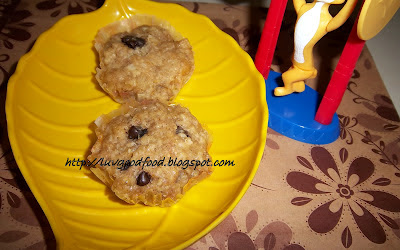Isn't the name begun chirer pulao, catchy? However, it is slightly misleading because it is not a pulao per se. It does not make a meal by itself but it does make a spicy, lip smackingly good side dish. The recipe is from Bong mom's cookbook. I have made changes to suit our palate.

What you need:
Brinjal/eggplant - 1 large, sliced into 1/2 inch thick rounds
Poha/flattened rice/aval - 1 cup
Thick curd - 1/2 cup
Turmeric powder - 1/2 tsp
Kashmiri chilli powder - 1 tsp
Salt - to taste
Garam masala - 1 tsp
Green chillies - 2 or 3, slit lengthwise
Asafoetida
Oil - 2 tsp + some more for drizzling over the brinjal and poha
Wash the sliced brinjals well. Sprinkle some turmeric powder and salt over the slices and let it rest in a colander for 15 minutes. Squeeze out excess water, drizzle some oil over the slices and then bake in a preheated oven at 175 degree centigrade for about 10-12 minutes, turning over once halfway through, until the slices start to shrivel up slightly on the edges. Time will vary depending on your oven. I have an option called Crisp in my microwave, which is what I used and it took me about 12 minutes.
While the brinjals are in the oven, getting cooked, mix the turmeric powder, chilli powder and a little bit of salt to the curd. Mix well and set aside.
Drizzle some oil over the poha and heat this in the microwave for about 2 minutes until the poha turns crisp.
Heat 2 tsp of oil in a thick bottomed pan. Add a generous few pinches of asafoetida and the slit green chillies. Saute for a minute. Now reduce the heat to low and add the curd mixture. Stir well and heat until you see oil separating from the mixture. Add half a cup of water and the baked brinjal slices. Mix well and let it come to a boil. When the mixture starts thickening and 3/4th of the water content has evaporated, stir in the crisp poha and the garam masala. Mix well and switch off the heat.
Serve immediately with rice/roti.
Check out the Blogging Marathon page for the other marathoners doing BM#22.

What you need:
Brinjal/eggplant - 1 large, sliced into 1/2 inch thick rounds
Poha/flattened rice/aval - 1 cup
Thick curd - 1/2 cup
Turmeric powder - 1/2 tsp
Kashmiri chilli powder - 1 tsp
Salt - to taste
Garam masala - 1 tsp
Green chillies - 2 or 3, slit lengthwise
Asafoetida
Oil - 2 tsp + some more for drizzling over the brinjal and poha
Wash the sliced brinjals well. Sprinkle some turmeric powder and salt over the slices and let it rest in a colander for 15 minutes. Squeeze out excess water, drizzle some oil over the slices and then bake in a preheated oven at 175 degree centigrade for about 10-12 minutes, turning over once halfway through, until the slices start to shrivel up slightly on the edges. Time will vary depending on your oven. I have an option called Crisp in my microwave, which is what I used and it took me about 12 minutes.
While the brinjals are in the oven, getting cooked, mix the turmeric powder, chilli powder and a little bit of salt to the curd. Mix well and set aside.
Drizzle some oil over the poha and heat this in the microwave for about 2 minutes until the poha turns crisp.
Heat 2 tsp of oil in a thick bottomed pan. Add a generous few pinches of asafoetida and the slit green chillies. Saute for a minute. Now reduce the heat to low and add the curd mixture. Stir well and heat until you see oil separating from the mixture. Add half a cup of water and the baked brinjal slices. Mix well and let it come to a boil. When the mixture starts thickening and 3/4th of the water content has evaporated, stir in the crisp poha and the garam masala. Mix well and switch off the heat.
Serve immediately with rice/roti.
Check out the Blogging Marathon page for the other marathoners doing BM#22.













































